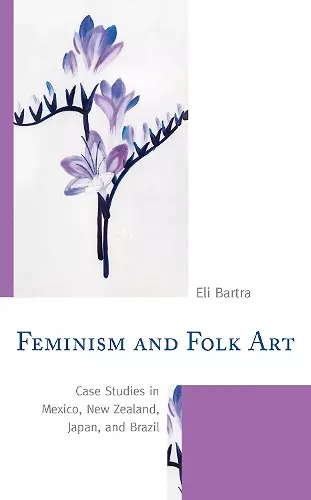Feminism and Folk Art
Case Studies in Mexico, New Zealand, Japan, and Brazil
Format:Hardback
Publisher:Bloomsbury Publishing PLC
Published:4th Jun '19
Currently unavailable, and unfortunately no date known when it will be back
This hardback is available in another edition too:
- Paperback£35.00(9781498564359)

This book is a mosaic or quilt of folk art around the world, from polychrome clay figures made in Izúcar de Matamoros, Puebla (Mexico) to the baskets Maori women create in New Zealand, from Japanese lacquer work and decorated paddles to black dolls in Rio de Janeiro, Brazil. The creative impulse found in three continents, four countries, and four geographical regions are juxtaposed to make up a harmonious whole. The book carries out a detailed dissection of a variety of ethnic, racialized, and gender representations in their contemporary forms.
Feminism and Folk Art offers a refreshingly delightful read of women artists working in different parts of the world, specifically, in Mexico, New Zealand, Japan, and Brazil. The book not only provides the history of folk art in these countries, but, more importantly, brings women from their hidden silences or “obscurity” into the limelight. For, by the very act of documenting their herstories in relation to their artistic endeavors, they become a vivid and viable part of posterity. . . . Feminism and Folk Art: Case Studies in Mexico, New Zealand, Japan, and Brazil is a very interesting and detailed book about the place and role of women folk artists in four geographical locations, situated in four countries and on three continents. The plurality of settings and experiences further adds to the importance of this book as a contribution to the discussion of women’s art from a feminist perspective. * Journal of Folklore Research *
Another terrific book by Eli Bartra, whose unique focus on contextualizing "folk art" from a feminist viewpoint has illuminated the art and lives of its often little-known makers. At home in many cultures, her careful attention to both artists and objects is an invaluable addition to the endless discussions of "high" and "low" art. -- Lucy R. Lippard, author of The Pink Glass Swan
In this innovative book, Latin American-based feminist and folklorist Eli Bartra ventures beyond her geographical comfort zone to take on a sophisticated comparative study of art and gender in Mexico, Japan, New Zealand, and Brazil. Her investigatory patchwork of four social and cultural environments—some rural, some urban—calls on specific ethnographic material in a variety of media to explore important theoretical questions, from the distinction between craft and folk art to the conception of gender. -- Sally Price, author of Co-Wives and Calabashes, Primitive Art in Civilized Places, and Paris Primitive
Eli Bartra with her recognized eye for grasping the intricate twisting of tradition, innovation, and inspiration inflected by gender, especially women’s experience, ambition, and generation, with class and necessity in works of art, creates a fascinating narrative that interprets art, folk art, and handicrafts. Her subtle and graceful analysis begins with objects (trees of Life in Mexico; woven baskets in New Zealand; lacquer products from Japan; and the rag dolls of Rio de Janeiro, Brazil) and quickly moves to a study of the persons who make them. The book should be read twice, once for the pleasure of the descriptive writing and once again for the refined, often understated scrutiny of these artistic case studies. -- William H. Beezley
ISBN: 9781498564335
Dimensions: 231mm x 160mm x 17mm
Weight: 426g
152 pages